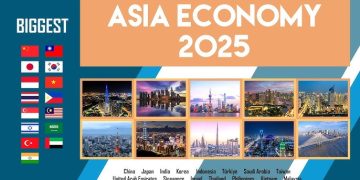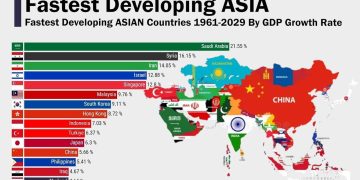1. A Shifting Tide in Global Capital
As 2025 unfolds, global investors are quietly redrawing their maps.
The pandemic-era mantra of “safe-haven first” — when capital crowded into U.S. treasuries, Swiss francs, and gold — is giving way to a more nuanced calculus: growth potential and regional resilience.
Nowhere is this transition more visible than in Asia. From Singapore’s asset management boom to India’s surging equity inflows, from Tokyo’s return to inflation to Beijing’s subtle fiscal recalibration, the Asian capital landscape is no longer a monolith defined by export-led surpluses or foreign reserve accumulation. It has become a mosaic of differentiated financial ecosystems, each adapting to new rules of liquidity, risk, and return.
While global GDP growth is slowing — the IMF projects a slide from 3.3% in 2024 to around 3.2% in 2025 — Asia’s story diverges. The region, home to more than half the world’s population and roughly 40% of global output, continues to attract capital not merely as a “hedge against Western stagnation” but as a strategic growth engine in its own right.
2. The Post-Dollar Adjustment
The first major shift shaping Asian capital flows in 2025 is the gradual diversification away from the U.S. dollar.
While the dollar remains dominant in global trade and finance, several structural trends are diluting its absolute hold. Central banks across Asia — notably in China, India, Indonesia, and Malaysia — are increasing the share of local-currency reserves and experimenting with bilateral settlement frameworks that bypass the dollar entirely.
In 2024, over 25% of ASEAN intra-regional trade was settled in non-USD currencies, up from just 12% in 2019. This shift reflects both geopolitical prudence and economic pragmatism: insulating trade from sanctions risk, while lowering transaction costs in a region where supply chains are increasingly localized.
Meanwhile, the Renminbi’s (RMB) regional influence continues to expand quietly. The People’s Bank of China (PBoC) has signed over 30 currency swap agreements with Asian central banks, and Hong Kong’s “dim sum” bond issuance surged 40% year-on-year in the first half of 2025. Though the RMB remains far from a true reserve currency, its regionalization is undeniable — forming the backbone of Asia’s evolving financial sovereignty.
3. India and ASEAN: New Centers of Gravity
If China defined the previous two decades of Asian growth, India and Southeast Asia are increasingly defining the next.
India’s GDP is expected to grow around 6.5% in 2025, driven by domestic consumption, infrastructure investment, and a tech-enabled services boom. Foreign portfolio inflows into Indian equities and government bonds exceeded $45 billion in the first half of 2025, according to Bloomberg data.
This momentum is not just cyclical. It is structural. India’s demographic dividend — 1.4 billion people, a median age under 30 — and its reforms in taxation, digital payments, and capital markets are pulling global investors into what one Morgan Stanley report called “Asia’s next structural bull market.”
Similarly, ASEAN’s integration under the Regional Comprehensive Economic Partnership (RCEP) is amplifying intra-Asian capital flows. Singapore’s sovereign wealth funds (Temasek, GIC) are ramping up exposure to Vietnam, Indonesia, and Thailand, where manufacturing and green energy projects are attracting both private equity and development finance.
The narrative is shifting: Asia is no longer just a destination for Western capital; it’s also the source. Asian cross-border investments now account for nearly 35% of total FDI within the region, signaling the rise of a self-sustaining investment ecosystem.
4. Japan’s Return from Deflation: The Surprise Catalyst
For the first time in three decades, Japan is no longer the world’s deflationary anchor. The Bank of Japan’s gradual normalization — lifting rates modestly from negative territory in late 2024 — has sent ripples through global carry trades.
As the yen strengthens and domestic yields rise, Japanese institutional investors are repatriating capital that once chased higher returns overseas. Pension funds and insurers, long major buyers of foreign bonds, are reallocating toward domestic assets — particularly equities and infrastructure plays benefiting from fiscal stimulus and corporate reforms.
This internal rotation is paradoxically stabilizing regional capital markets. While short-term liquidity tightens, long-term investment flows within Asia — especially between Tokyo, Seoul, and Singapore — are deepening. Japan’s return to positive interest rates adds maturity to Asia’s financial architecture: a balance between yield-seeking and capital retention.

5. China: Quiet Rebalancing Amid Strategic Patience
China’s role in 2025’s capital story is one of measured recalibration rather than spectacular resurgence. After years of property-sector deleveraging and export deceleration, Beijing’s policymakers are prioritizing stability over stimulus.
Foreign direct investment into China dipped 6% year-on-year in early 2025, yet outward investment surged 12%, particularly into Belt and Road economies and tech-supply partners in Southeast Asia.
This trend illustrates a dual strategy: sustaining influence via outbound capital while controlling speculative inflows at home.
China’s financial opening continues selectively — with the Qualified Foreign Institutional Investor (QFII) program expanding and Shanghai-Hong Kong-Shenzhen “Stock Connect” volumes reaching record highs. Still, global investors are recalibrating expectations: China is no longer the high-growth bet it was a decade ago but remains an anchor of macro stability in a volatile global system.
6. Digital Capital and the Fintech Wave
Beyond macroeconomics, Asia’s capital transformation is also technological.
By 2025, Asia accounts for over 50% of global fintech investment, driven by advances in digital banking, blockchain settlement systems, and AI-driven asset management.
Singapore’s digital asset exchanges, Hong Kong’s tokenized bond pilots, and India’s Unified Payments Interface (UPI) expansion into international remittances all point to a digitally networked capital environment.
This isn’t just innovation for its own sake — it’s infrastructure for capital mobility. Blockchain-based trade finance is reducing settlement times from days to hours, while tokenization is enabling fractional cross-border investment in everything from real estate to renewable projects.
In this digital realm, Asia is not following; it is leading.
7. Risks on the Horizon
However, the momentum is not without fragility.
The key risks facing Asian capital markets in the second half of 2025 include:
- U.S. monetary tightening: Higher U.S. yields could still trigger short-term outflows from riskier Asian assets.
- Geopolitical volatility: Tensions in the South China Sea, cross-strait relations, or energy supply disruptions could rattle investor confidence.
- Domestic debt burdens: Rising household and corporate leverage, particularly in China, South Korea, and Thailand, may limit fiscal flexibility.
- Regulatory fragmentation: Diverging approaches to digital assets and capital controls could hinder integration.
Still, compared to the debt-laden and politically polarized West, Asia’s relative stability and reform momentum offer a compelling asymmetry — limited downside, expanding upside.
8. Outlook: From Periphery to Powerhouse
The evolution of Asian capital flows in 2025 marks a profound structural turn.
What began as a reactive shift — hedging against Western fragility — is maturing into a proactive regional reconfiguration. Asia is becoming not just a participant in global finance but a producer of capital, innovation, and liquidity.
In the next decade, analysts predict that intra-Asian investment could surpass Asia-to-West flows for the first time in modern history.
If this materializes, it would signify the culmination of a long arc — from dependency on export capital inflows to financial self-determination.
As one Singapore-based fund manager put it, “The future of global capital isn’t East versus West anymore. It’s East with East — and the rest following the flow.”
































